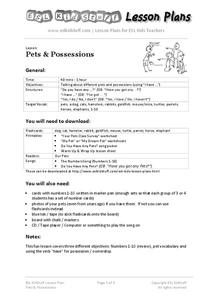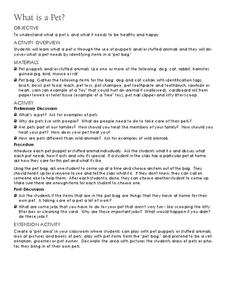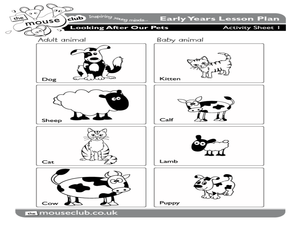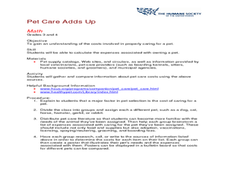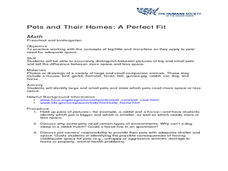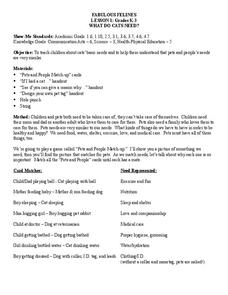Curated OER
The Tale of Peter Rabbit
Wow! Here is a most-impressive series of lessons and activities that revolve around the classic story, The Tale of Peter Rabbit. The purpose of the lessons are to provide an agricultural theme in the reading, writing, and science...
ESL Kid Stuff
Pets & Possessions
Language learners engage in a series of games and activities using pet vocabulary and the verb "have" to show possession or ownership.
Curated OER
What is a Pet?
Learners define what a pet is and what it needs to be healthy and happy. They explore pets through the use of of puppets and/or stuffed animals and discover what a pet needs by identifying items in a "pet bag."
Curated OER
The Velveteen Rabbit
First graders discuss and touch stuffed animals and a real rabbit. They complete a KWL chart about rabbits. They listen to the story The Velveteen Rabbit and discuss it. They research rabbits in the library and make a book.
Curated OER
Literacy Activity: The Perfect Pet
Students develop their listening skills as they listen to the book The Perfect Pet. In this reading lesson, students listen to the book, and then talk about the pets they have. Then they make a graph as a class of all their pets.
Curated OER
Looking After Our Pets
Students explore animal lifestyles by illustrating images. In this pet care lesson, students discuss their own pets and the conditions animals need to survive in both nature or a home. Students draw snakes and complete an activity sheet...
Curated OER
Pet Care Adds Up
Students calculate the costs of properly caring for a pet. In this animal welfare lesson, students use pet supply catalogs and websites to gather information about the cost of caring for a pet. Students are divided into groups and are...
Curated OER
Comparing Hares and Rabbits
Sixth graders research and investigate the Arctic hare and the snowshoe hare, and the order hares and rabbits. They explore an animal website and compare/contrast the two animals, recording their data on a chart.
Curated OER
Pet Overpopulation
Learners examine pet overpopulation. In this animal welfare lesson, students discuss the causes and effects of pet overpopulation. Learners color in an animal page and identify the responsibilities of owning a pet.
Curated OER
Pets and their Homes
Students explore the space needed for an animal to live in. In this pets lesson, students view pictures of animals and decide which one needs more space or less space to live. Students discuss animals environments and why certain spaces...
Curated OER
Pet Overpoulation: Fact or Fiction
Students examine the benefits of spaying and neutering animals. In this animal welfare lesson, students define the terms "spaying" and "neutering." Students listen to a lecture about the benefits of spaying and neutering and complete a...
Curated OER
What Do Dog's Need?
Students discuss proper care of pets. In this animal care lesson, students discuss what pets need to be healthy and happy. Students act out roles of pets and owners and create a pet tag.
National Wildlife Federation
What's Your Habitat?
How are third graders like rabbits? They both live in habitats and require food, water, and shelter to survive! An educational science activity encourages your learners to think about their own habitats and survival needs, before...
Curated OER
Help! There Are Too Many Dogs and Cats and Not Enough Homes!
Students discuss the importance of spaying and neutering pets. In this animal care lesson, students create a make believe animal shelter. They discuss what happens to animals in the shelter and if no one wants to take them home.
Curated OER
Fabulous Felines
Students explore basic needs through discovering that pets and people need very similar things. They will play matching games, sing songs, read books, and discuss the needs of people and animals.
Curated OER
What is a Pest?
Students investigate whether rabbits should be considered pests even though they make good pets. They extend this to determine what, when, and where other organisms are considered to be pests, and examine why the concept of a pest is a...
Curated OER
Where Do Animals Live?
Students c;assify where pets live and where wild animals live and comprehend the differences. They investigate what kinds of homes pets and wild animals need. Students bring in a stuffed animal or puppet from home and match their...
Curated OER
Describing Animals
Students investigate different types of pets. In this pets lesson, students discuss a variety of animals and their habitats. Students complete activities such as pet pictionary, pets as fashion accessories, role playing pet...
Curated OER
Respect for Animals
Students discuss importance of acting responsibly when caring for pets, reflect upon quote, "All Living Beings Have the Right to Respect and Kindness," read story Anastasia Wants a Rabbit and answer comprehension questions, role play...
National First Ladies' Library
Flopsy, Mopsy, Eleanor, and Beatrix
Young scholars read "The Tale of Peter Rabbit" and view the photos of the pets that inspired Beatrix Potter to write. They then select a different book to read from the University of Pennsylvania's website or from the public library that...
Curated OER
Making Comparisons of Living Things
In this comparing living things worksheet, pupils examine pairs of pictures that show living organisms such as a snail, a cat, a butterfly, a giraffe, and a rabbit. They look at pairs of pictures and orally answer questions using...
Curated OER
A Trip To the Animal Fair
Students share their experiences they have had with animals. Using photographs of their own pets, they create a booklet out of construction paper in which they identify the pets needs. They also compare and contrast what they need to...
Curated OER
Body Parts Worksheet: Ears
Hre is an ESL and printing practice worksheet. Learners trace six examples of the word "ear" before forming their own words on the primary lines. They color the pictures of the ears.
Curated OER
Counting in Pairs: Animal Homes
In this counting by 2 worksheet, students draw a line from each pair of animals to their home. Students count the total number of animals of each type.



